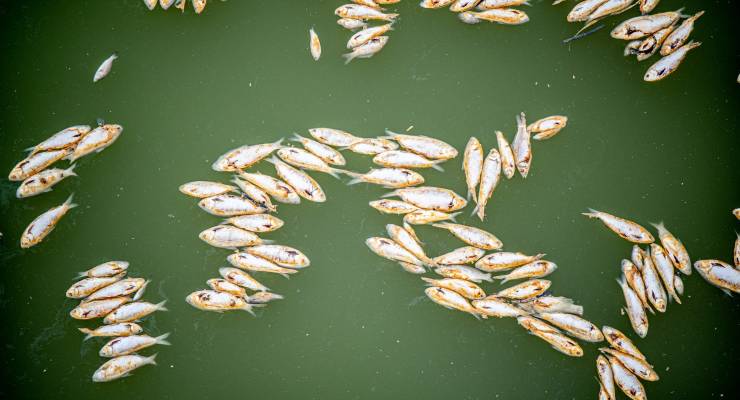
The sudden death of millions of fish in the Darling-Baaka River has triggered heartbreak and frustration in NSW’s far west.
Emotions ran high at a community meeting in Menindee on Tuesday, where government officials who tried to assure residents the local water was safe to drink were made to sip cups of it in front of the crowd.
Days before, the river flowing through Menindee had been filled with floating dead fish, choked to death by extremely low oxygen levels in the water.
It seems almost certain the fishkill, and the state government’s handling of flooding in the area earlier in the year, will be the subject of a parliamentary inquiry, with several parties backing the idea.
The NSW Greens have also called for a royal commission into the eco-disaster.
“The Menindee community deserves answers and action from the government about why their river is dying. They’re extremely frustrated,” said upper house Greens MP Cate Faehrmann, who attended Tuesday’s meeting.
It’s the second time in four years a fish kill has occurred at Menindee.
“It’s not like it was before in 2019. This time we’ve got three or four more the number of dead fish in the system,” Barkindji Elder Barbara Quayle told the meeting.
“These fish are our totems of the Barkindji people along the river so it’s very, very sad to see this happening to our system again.”
A police-led emergency operations centre set up by state authorities to coordinate the response to the fish kill said early signs pointed to hypoxic blackwater as the cause — “a naturally occurring phenomenon which causes extremely low dissolved oxygen levels”.
“The scale of this event has been exacerbated by recent hot weather and significantly increased numbers of fish in the system as floodwaters recede,” a press release from the centre said.
There are many unanswered questions as to what went wrong — including whether the fish could have been saved if the Menindee weir had been open, allowing them to escape to nearby lakes with more oxygen-rich water.
Another mystery is a set of faulty water gauges that appear to have caused important data on the river to go missing.
“The data for the flows is not available on the Water NSW website, which is highly unusual, really odd,” water management expert Maryanne Slattery told Crikey.
The federal government’s Murray-Darling Basin Authority says on its website that flow measurement at the weir was “suspended due to high flows” that coincided with the floods.
A graph on the website goes blank after November 23 2022 and doesn’t pick up again until March 15 this year.

Some locals have also questioned whether the deadly lack of oxygen in the water was exacerbated by chemicals in the water, although there is no evidence for it.
“What tests of the water have been conducted by the government?” asked Menindee farmer Rob McBride, who went viral during the 2019 fishkill with a video where he held up an enormous dead fish.
“This is a catastrophe of epic proportion. What about testing for residue coming out of the cotton plantations upstream?”
Ian Cole, secretary of the lobby group Bourke Cotton Growers’ Association, said any such suggestion was “bullshit”.
“None of the farmers on the river use any chemicals that reduce oxygen in the water,” he told Crikey.
“They just want to blame somebody, and now they’re pointing their fingers upstream, but they’re ignorant of the science.”
Faehrmann said that while the short-term causes were still unknown, she had “no doubt” water mismanagement contributed in the long term.
“There’s no doubt though that decades of mismanagement and over-extraction by big irrigators in the Northern Basin, including by floodplain harvesting, is resulting in more frequent and severe fish kills,” she said.
NSW Premier Dominic Perrottet said earlier in the week that recent floods had contributed to the fish kill.
“Obviously off the back of floods it has caused significant challenges right across our regional communities,” Perrottet said.
“We’ve seen the flooding hasn’t just had impacts on our roads, it’s had an impact on our river systems as well.”
Labor Leader Chris Minns said Labor would seek to support the state’s far west in improving river management “no matter what happens at the election this Saturday”.
“Labor will be calling for an investigation into how an event of this scale occurred and whether it could have been avoided or minimised, as it seems to go beyond what is natural or normal.”
Barwon independent MP Roy Butler, who visited Menindee on Thursday, joined calls for an inquiry.
He said he’d been told organic matter that had swept off the floodplain during floods had decomposed in the river and sucked the oxygen out.
“That’s the official line … but there needs to be an independent inquiry to actually confirm that is what happened, to give the community some reassurance,” he said.








We need to be calling this what it is – millions and millions of living creatures suffocating to death.
The complete mismanagement, run down and degradation of an ecosystem that extends for hundreds of miles – to serve a small constituency of National Party donor irrigators and their ‘dependents’?
How do millions of fish manage to grow to maturity and then die off in the space of what, three months at best? The bony bream must be the fastest growing species on the planet to have multiplied to this level. How does a river after a full flood suddenly become depleted of oxygen due to ‘organic matter’ decomposing, when prior to that there’s been a drought for a decade or more, and precious little organic matter over the entire flood plain? I’d love to see the report, except that it may be buried someplace along with the fish.
Murray Darling river management is just like the dead fish; rotten.
This is absurd and really does require a Royal Commission iunto the chicanery of NSW water and the Nationals long term rorting of licences. We have seen a few cotton growers prosecuted for water theft, but how many others did this. The idea that a high river flow causes fish deaths is absurd unless it is carrying a huge amount of organic matter or toxic sediments. The vegetation should not matter if there is flow, but clearly the river was trapped by the management setup. The weather was not hot by the standards of the area. One issue might be that the flushing out has mobilised some nasty sediments not seen much before as it is a long time since a big flood managed to traverse the system. A light must be shone into this world.
read the science old grey bearded one
The cotton industry and floodplain harvesting must be scaled back. Shut down Cubby Station which robs graziers of stock water.
Plenty of water in the lakes, why didnt they give the river a flush? Main Menindee weir stayed shut, according to @gergyl on Twitter.